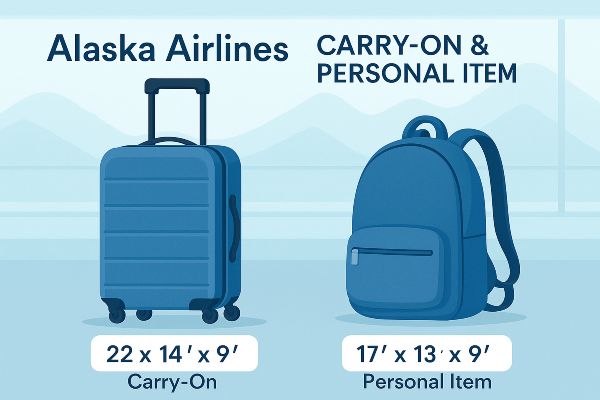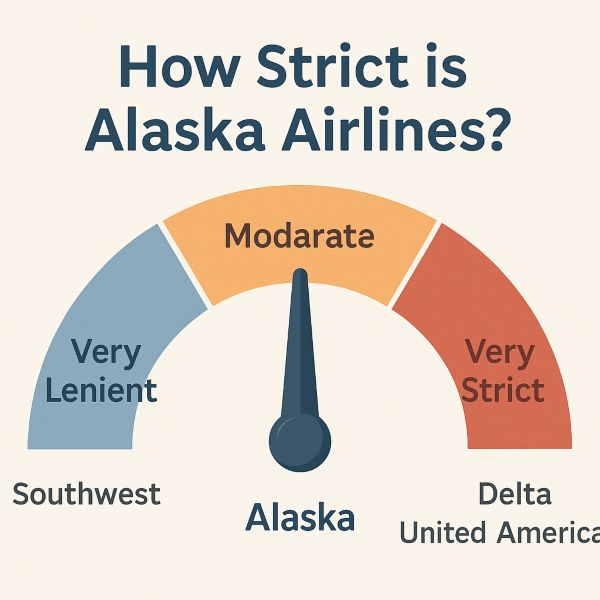If you’re planning a trip with Alaska Airlines, you’re probably wondering what exactly you can bring on board without getting stopped at the gate. The good news? Alaska Airlines is one of the more traveler-friendly carriers in the United States when it comes to carry-on baggage. That said, there are still specific size rules, personal item limits, and little quirks that can catch people off guard.
In this guide, I’ll walk you through everything you need to know about Alaska Airlines’ carry-on policy for 2025. I’ll also share a few real-world tips, packing hacks, and even some bag recommendations that fit perfectly within their rules. So whether you’re flying from Seattle to LA or taking a longer route to Hawaii, this article should save you some stress (and possibly some money).
Alaska Airlines Carry-On Size & Dimensions
Alaska Airlines allows one carry-on bag plus one personal item for free.
The maximum size for a carry-on bag is:
-
22” x 14” x 9” (56 x 36 x 23 cm)
-
This includes wheels and handles.
If your bag fits these dimensions, it should go in the overhead bin with no problem. The airline designed this rule so that all passengers can fit their carry-on bags in standard bins.
One nice thing about Alaska is that they don’t tend to nitpick if your bag is half an inch bigger. I’ve personally flown with a slightly larger soft-sided duffel that squished into the bin just fine. Still, if your bag is obviously oversized, there’s a good chance the gate agent will tag it for gate check.
Quick comparison with other airlines:
-
Delta and United have the same 22 x 14 x 9 rule.
-
Southwest is slightly more relaxed but still within that range.
-
Budget airlines like Spirit and Frontier? Way stricter—sometimes they’ll charge you extra even if your bag looks fine.
So in the grand scheme of things, Alaska is middle-of-the-road but definitely not harsh.

Alaska Airlines Personal Item Rules
In addition to your main carry-on, you can bring one personal item that fits under the seat in front of you. The maximum size is:
-
17” x 13” x 9” (43 x 33 x 23 cm)
This is actually pretty generous. A backpack, small duffel, laptop bag, or even a roomy tote usually fits without issue.
For example, I’ve seen travelers bring in backpacks stuffed with jackets, snacks, and electronics and nobody batted an eye. As long as it slides under the seat, you’re good.
👉 Pro tip: If you want to maximize space, put your heavier items (like books, cameras, or shoes) in your personal item. Alaska doesn’t weigh carry-ons, so you can really use this to your advantage.
Carry-On Weight Restrictions
Here’s the part I love: Alaska Airlines does not have a weight limit for carry-on bags.
That means if you’re carrying a backpack full of camera gear or a laptop bag that weighs more than your dog, it doesn’t matter—as long as you can lift it into the overhead bin yourself.
This is a big deal compared to international airlines. For example, many Asian and European carriers have strict weight limits (sometimes only 7–10 kg for carry-ons). If you’re connecting from an Alaska flight to an international one, keep that in mind.
| Airline | Carry-on size | Personal item (rule / size) | 1st checked bag* | 2nd checked bag* |
|---|---|---|---|---|
| Alaska | 22″ × 14″ × 9″ | 1 free; under-seat (no set size) | $35 | $45 |
| Delta | 22″ × 14″ × 9″ | 1 free; under-seat | $35 | $45 |
| United | 22″ × 14″ × 9″ | 1 free; 17″ × 10″ × 9″ — Basic Economy: personal item only (no full-size carry-on) | $35 online / $40 airport | $45 online / $50 airport |
| Southwest | 24″ × 16″ × 10″ | 1 free; under-seat (~18.5″ × 13.5″ × 8.5″) | $35 † | $45 † |
Exceptions & Special Items
Alaska also makes exceptions for certain items that don’t count against your personal item or carry-on. These include:
-
Diaper bags (if you’re traveling with an infant).
-
Medical devices (CPAP machines, oxygen concentrators, etc.).
-
Duty-free purchases from the airport.
-
Assistive devices like canes or crutches.
-
Musical instruments, as long as they fit in the overhead or under the seat.
-
Sports equipment: Some smaller items like a tennis racket can be carried on, but larger gear will count as checked baggage.
This flexibility is especially helpful for parents and business travelers.
Alaska Airlines Checked Bag Policy (Quick Overview)
Even though this article is about carry-ons, let’s quickly touch on checked bags since it often ties into the decision of how much you pack.
-
First checked bag: $35
-
Second checked bag: $45
-
Third+ bags: $150 each
-
Overweight bags (51–100 lbs): $100 extra
-
Oversize bags (63–115 linear inches): $100 extra
Compared to Southwest (which includes 2 free checked bags), Alaska’s fees are on the pricier side. But they’re very much in line with United, Delta, and American.
This is why it pays to be smart with your carry-on. If you can fit everything into your carry-on and personal item, you save $35–$80 each trip.
How Strict is Alaska Airlines with Carry-Ons?
Now the big question: how strict is Alaska really?
From both my own experiences and reports from frequent flyers, Alaska isn’t the strictest airline out there. As long as your bag looks reasonable and fits in the overhead bin, you’ll probably be fine.

That said, here are a few things to watch out for:
-
Busy flights: On packed routes (like to Hawaii or during holidays), gate agents may be stricter.
-
Boarding group: If you’re boarding in the later groups, overhead space may already be full, and you might be forced to gate check.
-
Obvious oversize bags: Hard-sided bags that clearly don’t fit dimensions might get tagged.
Overall though, Alaska is more lenient than United or American but not quite as relaxed as Southwest.
Packing Tips for Alaska Airlines
Want to make the most of your allowance? Here are a few tricks that work every time:
-
Choose a soft-sided bag. These squish into overhead bins better than hard cases.
-
Use compression packing cubes. They save tons of space and keep your bag organized.
-
Put heavy stuff in your personal item. Since there’s no weight limit, you can load it up.
-
Wear your bulkiest items. Jackets, boots, and hoodies take up space in a bag, so wear them on the plane.
-
Use every pocket. Airlines don’t measure every zipper pouch, so maximize the design of your bag.
Recommended Carry-On Luggage for Alaska Airlines ✈️
If you’re looking to upgrade your travel gear, here are a few solid options that fit perfectly with Alaska’s carry-on limits:
-
Samsonite Winfield 2 Hardside Luggage 20”
-
Sleek design, scratch-resistant shell.
-
Lightweight yet durable.
-
Fits within Alaska’s 22” x 14” x 9” limit.
-
Pros: Stylish, tough, glides smoothly.
-
Cons: Less flexible space compared to soft-sided bags.
-
-
Travelpro Maxlite 5 Softside Expandable Luggage 19”
-
Frequent flyer favorite.
-
Lightweight and expandable.
-
Soft-sided design makes it easier to fit in bins.
-
Pros: Very roomy, airline-approved size.
-
Cons: Fabric shell can scuff.
-
-
Amazon Basics 21” Hardside Spinner
-
Budget-friendly choice that still gets the job done.
-
Smooth spinner wheels.
-
Surprisingly durable for the price.
-
Pros: Affordable, functional.
-
Cons: Not as premium as Samsonite or Travelpro.
-
👉 These three options cover different budgets and styles, but they all fit Alaska’s rules.
FAQs About Alaska Airlines Carry-On Rules
Does Alaska Airlines charge for carry-on bags?
Nope. Both your carry-on and personal item are free.
Can I bring a backpack and a carry-on?
Yes. A backpack counts as your personal item as long as it fits under the seat.
What happens if my carry-on is too big?
It will be gate-checked for free on full flights. If it’s clearly oversized, you might be asked to check it at the counter (and pay the fee).
Does Alaska Airlines allow pets in the cabin?
Yes, but the pet carrier counts as your carry-on. It must meet specific size requirements.
Is overhead bin space guaranteed?
No. If you’re in a later boarding group, overhead space might be gone and your bag could be gate-checked.
Final Thoughts
Alaska Airlines has one of the more straightforward and passenger-friendly carry-on policies in the US. Their size rules are standard, they don’t weigh carry-ons, and they allow both a bag and a personal item for free. Compared to budget carriers, that’s a big win.
My advice? Stick to the 22” x 14” x 9” guideline, make good use of your personal item, and if you’re investing in new luggage, go for something that’s guaranteed to fit. That way, you’ll avoid any stress at the gate and maybe even save some money on checked baggage.
Happy flying, and may your carry-on always find overhead space ✈️

Horace Dupuy is a seasoned traveler and luggage reviewer who has spent years flying with both major and regional airlines across the United States and abroad. His first-hand travel experience has taught him exactly what works (and what doesn’t) when it comes to carry-on rules, baggage fees, and packing strategies.
At CarryOnSizes.com, Horace combines personal travel knowledge with in-depth research to provide accurate, up-to-date guides for travelers who want to fly stress-free. When he is not writing about luggage, you will probably find him exploring new destinations with only a compact backpack in tow.
